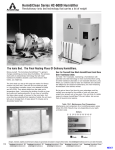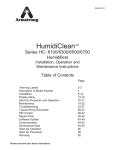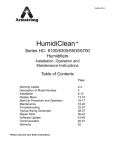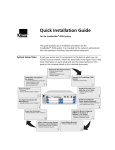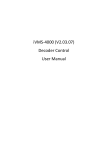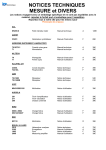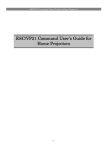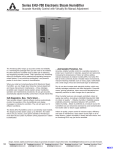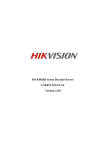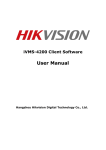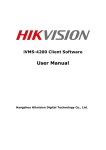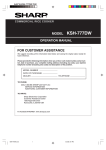Download HC6000 Brochure
Transcript
Bulletin 583 HumidiClean Series HC-6000 Humidifier Revolutionary ionic bed technology that carries a lot of weight The Ionic Bed. The Final Resting Place Of Ordinary Humidifiers. Brace yourself. The Armstrong HumidiClean™ is going to change everything you know about humidifiers. The process starts with an extraordinary technology that will make traditional humidifiers obsolete. Leave them dead in their tracks, you might say. The ionic beds you see on this page are made of a fibrous medium: the ionic bed. There are six such beds per tank in a HumidiClean humidifier (more in the Models HC-6500 and HC-6700). They attract solids from the water as its temperature rises – minimizing the buildup of solids on inner tank walls and heating elements. So you have a humidifier that stays clean except, of course, for the ionic beds. And once they have absorbed their capacity of solids, the unit even tells you to change them. It takes about 15 minutes and is absolutely hassle free. See For Yourself How Much HumidiClean Could Save Over Traditional Units As Table 1-1 illustrates, maintaining a HumidiClean with patented ionic bed technology is more economical than caring for either traditional cleanable or non-cleanable electronic units. When you combine costs for labor and materials and calculate the differences for seasonal maintenance, the new Armstrong HumidiClean is the obvious winner. But to get an idea of just how big your advantage could be, multiply your savings by the number of units you have and project your answer over a few years. Can you think of a better reason to choose HumidiClean? We can’t either, but we can think of several more reasons. Table 1-1. Maintenance Cost Comparison Maintenance cost comparison for a humidifying season using Model HC-6100. Results may vary depending on your parts and labor costs. Dollars $0 50 100 150 200 250 300 350 400 450 HumidiClean $215 Per Season Cleanable $350 Per Season Non-Cleanable $450 Per Season Parts 1 Labor Armstrong Humidification Group, 816 Maple St., Three Rivers, MI 49093 – USA Phone: (269) 273-1415 Fax: (269) 273-9500 www.armstronginternational.com HumidiClean Passes No Current Through Water HumidiClean’s resistance-type design has a proven track record for safety. Totally different compartments keep plumbing completely separated from electrical components. is to eliminate sodium. Since this is typically only necessary approximately once every 12 hours, the unit wastes much less hot water,thereby saving energy dollars. In addition, Armstrong has built several other safety features into HumidiClean. These include a key-locked access door, password protected programmable keypad, diagnostic indicating LCD display, continual-checking diagnostic routines, highand low-water level detection, internal tank temperature sensing, overcurrent protection and connections for a Class 2 alarm device. HumidiClean Series HC-6000 Offers Enhanced Control of Room RH HumidiClean uses submersed electric heating elements to generate steam. In other words, water quality or conductivity do not affect the unit’s ability to generate full output on demand. Although normally used with tap water, HumidiClean can, upon request, be installed with deionized, demineralized, softened or reverse osmosis water sources. Said another way: You get the benefit of a humidifier capable of operating over a wide range of water quality without frequent replacement of parts or bothersome, messy cleaning. Less Scale Means Greater Efficiency HumidiClean uses SCR controls as standard on all units for full modulation of steam output. The humidifier's responsiveness to increased demand is enhanced through the use of an aquastat to maintain a minimum water temperature in the tank during short periods of no demand. The unit also modulates fill of makeup water into the tank to prevent reduction of steam output during the fill cycle for consistent and responsive output of produced steam. HumidiClean Communications Capability HumidiClean Series HC-6000 offers native MODBUS communications protocol as well as a Class II alarm circuit for monitoring purposes. Optionally, HumidiClean may be ordered to operate with either BACnet or LonWorks protocols. Capacity is the first victim of the scale that quickly builds up in traditional evaporative or steam-generating humidifiers. As scale gathers in the pan or on heating elements or electrodes, output declines. This gradually leads to a loss of humidity control. From this point on, things get steadily worse – until cleaning or the replacement of parts occurs. Why Humidify? HumidiClean with its remarkable ionic bed technology builds up deposits on its ionic bed inserts instead of tank walls or heating elements. As a result, it operates efficiently longer, its tank stays cleaner longer, and it maintains nearly maximum output throughout its service life. Dry air can also increase static electricity buildup, potentially impacting production or the use of office equipment. Computer rooms, printing operations, clean rooms and laboratories are especially sensitive to static charges due to dry air. Low RH also affects indoor air quality. Ionic Bed Technology Saves Energy Steam is virtually a sterile medium offering many sanitation benefits over other types of humidification. It is recommended for essentially all commercial, institutional and industrial applications. Because of carbonate buildup, most humidifiers drain every 20-45 minutes. HumidiClean’s ionic beds attract these carbonates from water, so the primary reason to drain the tank As the temperature of indoor air goes up, its relative humidity (RH) goes down. When RH falls to levels commonly found in heated indoor environments, moisture-retaining materials such as wood, paper, textile fibers and a wide range of food and chemicals begin to deteriorate. Ionic Bed Technology New ionic bed After 400 hours After 800 hours These microscopic photos show how the ionic bed fibers (magnified 52.5X) collect solids throughout their service life. A new ionic bed weighs approximately 1/3 pound. When it reaches its capacity, an ionic bed may weigh more than 2-1/2 pounds. A light on the control panel indicates when to replace HumidiClean’s beds. Armstrong Humidification Group, 816 Maple St., Three Rivers, MI 49093 – USA Phone: (269) 273-1415 Fax: (269) 273-9500 www.armstronginternational.com 12 How HumidiClean Works When power is supplied to the unit, the water fill valve energizes, and water enters the tank. Once the level reaches the low-water switch, the heating elements are energized (assuming there’s a call for steam output). The unit continues to fill until the high-water switch is energized. The humidifier then produces steam in response to the humidistat’s input signal. The tank will fill at regular intervals if all conditions remain constant. Periodic tank drainage is based on active time of the heating elements, but may be field-adjusted to water conditions. The HumidiClean power module accepts a proportional signal and, in response, pulses power to the heating elements to provide fully modulated output. Steam output is continuously adjusted to satisfy necessary humidity requirements. The standard HumidiClean includes the Armstrong modulating control humidistat with a 0-10 Vdc control signal. The unit is field-adustable to accept any of the following common control signals as the main control signal: on/off (SPST relay), 0-10 Vdc, 4-20 milliamp, 0-5 Vdc. Additional input terminals are provided for on/off air flow and duct high-limit humidity controls. the tank, sliding them out through the access opening. Further cleaning of the tank or heating element surface is typically not required. Install new beds in the same manner, sliding them through the access panel and positioning them on the holding pins. After all beds have been replaced, replace the tank access panel and outer cover. Turn the power on at the main power disconnect. Toggle to and reset EOL. Unit will fill with water and return to normal operation. Total service time is usually no more than 15 minutes. (Used ionic beds contain no environmentally hazardous material and may simply be thrown away.) Drying Cycle If there is no demand for steam for a continuous 72-hour period, HumidiClean initiates a routine to dry ionic beds by draining and energizing the heating elements for short intervals. This drying cycle eliminates standing water concerns and improves indoor air quality. Completing A Service Life Cycle After the ionic beds have absorbed 90% of their capacity, the LCD display will flash the “EOL” (end of life) message. (See control panel photo.) If the HumidiClean is not serviced by replacing the ionic beds and re-setting the EOL, the unit will continue to produce steam on demand for the remaining 10% of ionic bed capacity. During this period, the unit will display a flashing “EOL” message. After the ionic beds have reached 100% capacity, the unit will shut down by draining the tank and will not respond to any call for humidity. Servicing the unit is now required. The service life cycle is field-adjustable to accommodate varying water quality and the specifics of the individual application. Simple Bed Removal Toggle from “STEAM GENERATION” on the LCD to “MANUAL DRAIN”. This will cause the unit to drain. When this drain is complete, turn the main power off at the disconnect. Use caution as tank will still be quite warm. Remove screws from outer cover. Remove wingnuts from access panel. Remove old beds by pulling them up and off the holding pins in Series HC-6000 Control Panel The HumidiClean control panel is designed to quickly and simply display operating conditions. If an error is detected, a diagnostic display indicates the specific condition. Service As Easy As One, Two, Three Step 1. Remove HumidiClean outer cover and remove tank access panel. Remove the old ionic bed inserts. 13 Step 2. Install new inserts in place of the old ones. Step 3. Reinstall tank access panel and outer cover. Restart HumidiClean. Armstrong Humidification Group, 816 Maple St., Three Rivers, MI 49093 – USA Phone: (269) 273-1415 Fax: (269) 273-9500 www.armstronginternational.com Selection and Ordering Procedure Consider the following factors to select and order the proper unit. 1. Compute the capacity required. You must compute the maximum amount of moisture required to determine that HumidiClean is properly sized for service. For detailed information on calculating humidification loads, refer to the Humidification Engineering section of this catalog or Armstrong’s Humid-A-ware™ humidification sizing and selection software. Both may be downloaded from Armstrong’s web site at www.armstrong-intl.com. Humidification loads are generally sized on a worst-case basis where design conditions exist for a limited time and do not require a safety factor. HumidiClean is designed to drain infrequently, because accumulation of tank solids is not as problematic as with other humidifiers. This conserves water and energy. There will be a short period during this drain cycle when there will be no steam output. Consult your Armstrong Representative or the factory if this poses a control problem for your system. Example: Assume the humidification load is 38 lbs/hr (17.3 kg/hr) and available power supply is 480 volt/3 phase. Referring to Table 8-3, Page 8, we find a 15 kW Model HC-6100 HumidiClean is required. The branch circuit should be rated for 25 amps. See Table 8-2, Page 8. using insulated copper tubing. The maximum recommended distance is 40 feet (12 meters) of equivalent length copper tubing. See Installation, Operation and Maintenance Bulletin 539 for additional guidelines. 5. Specify spare ionic bed inserts. If HumidiClean is going to be in continuous service on a yearround basis, Armstrong recommends the purchase of a spare set of beds. Duct Unit 6. Specify steam dispersion tube (Table 4-1). Select the proper steam dispersion tube that meets the duct requirements. As an example, if the duct in which you are installing the humidifier has a width between 17” and 22”, you should use the steam dispersion tube(s) D-1.5 (DL-1.5 for HC-6300, HC-6500 or HC-6700). Alternatively, specify HumidiPack™ and indicate the following: • Duct height and width • CFM • Duct air temperature • Final duct RH% • Non-wettable vapor distance available • Maximum allowable air pressure drop (inches W.C.) Figure 4-1. Dispersion Tube 2. Specify electrical characteristics of unit required. L Specify the voltage, kW, phase and cycles for unit on the order. Determine total amperage for installation purposes. Forcapacities cap acities For to to 40 (18(18 kg/hr) 40lb/hr lb/hr kg/hr) 3. Specify the humidity level and range. The standard Armstrong humidistat is 0-10 Vdc control and is adjustable by a front-mounted dial from 5-95% RH. Specify room or duct type humidistat. Or you may provide your own humidistat and/or controller. If you are providing your own controller, specify control signal type. 2" L 2" 4. Use proper connecting materials. Two short hose cuffs per dispersion tube are provided to be used with 2” (nom.) hard copper tube to connect the tank to the steam dispersion tube (if applicable). Armstrong recommends Forcapacities cap acities above For above 40 lb/hr (18 kg/hr) 40 lb/hr (18 kg/hr) Table 4-1. Selecting Proper Steam Dispersion Tube Steam Disp. Tube Model # HC6100, HC6100DI HC-6300, HC-6300DI, HC-6500, HC-6500DI, HC-6700, HC-6700DI Steam Disp. Tube Length Duct Width Min. in 12 18 24 36 48 60 72 84 96 108 120 mm 304 457 609 914 1219 1524 1829 2133 2438 2743 3048 in 11 17 23 35 47 59 71 83 95 107 119 D-1 DL-1 D-1.5 DL-1.5 D-2 DL-2 D-3 DL-3 D-4 DL-4 D-5 DL-5 D-6 DL-6 D-7 DL-7 D-8 DL-8 D-9 DL-9 D-10 DL-10 HC6100, HC6100DI Model "D" Diameter is 1-1/2". HC6300, HC6300DI, HC6500, HC6500DI, HC6700, HC6700DI Model "DL" Diameter is 2-3/8". Models HC6500 and HC6700 require a minimum of (2) dispersion tubes. Weight Max mm 279 432 584 889 1194 1499 1803 2108 2413 2718 3023 in 16 22 34 46 58 70 82 94 106 118 130 mm 406 559 864 1168 1473 1778 2083 2388 2693 2998 3302 lb 3 3 4 6 8 9 10 11 12 13 14 kg 1.4 1.4 2 3 3.6 4 4.5 5 5.5 6 6.4 All dimensions and weights are approximate. Use certified print for exact dimensions. Design and materials are subject to change without notice. Armstrong Humidification Group, 816 Maple St., Three Rivers, MI 49093 – USA Phone: (269) 273-1415 Fax: (269) 273-9500 www.armstronginternational.com 14 Selection and Ordering Procedure, continued… • 7. Specify water source. Specify if the service will include tap, deionized, demineralized, softened or reverse osmosis water. 8. Specify options required. • Duct high-limit humidistat. (Recommended). You may order a duct high-limit stat. A typical setting for the high-limit stat is 85% RH. Stat opens when relative humidity exceeds settings. A modulating high-limit stat is also available for VAV systems. Figure 5-1. HC-6100 or HC-6300 Duct Type Distribution Fan interlock. (Recommended). You may order a duct pressure switch to activate the humidifier by sensing air flow in a duct system. The pressure switch prevents humidifier operation if there is insufficient air movement in the duct system. Area Unit 9. Specify a fan package for each HumidiClean. The EHF-3 offers a remote mounted, direct area discharge option for use with HumidiClean (See Figure 5-3). EHF-3 offers capacities to 120 lbs/hr (54 kg/hr). A minimum of two EHF-3 fan units are required for Model HC-6500 or HC-6700. Please consult factory when applying EHF-3 fan package with Model HC6700. Air Flow Figure 5-4. HC-6100 or HC-6300 HumidiClean Piped to HumidiPack Air Flow 10” Water Seal (min.) Figure 5-2. HC-6100 or HC-6300 with Duct Located below HumidiClean 6” Min. Figure 5-5. HC-6100 or HC-6300 General Installation Concept 3/8” OD Tubing “P” Trap Water Seal Steam Piping 1”/12” Pitch Piping Back Figure 5-3. HC-6100 or HC-6300 with EHF-3 Fan Package Mounted on Wall Duct 4” Min. Close to Main Power Disconnect Dispersion Tube Valved Water Supply Maximum Piping Run 20 Feet 1” 1” Pitch Drain Piping 1”/12” on Horizontal Runs 15 Armstrong Humidification Group, 816 Maple St., Three Rivers, MI 49093 – USA Phone: (269) 273-1415 Fax: (269) 273-9500 www.armstronginternational.com Installation Concepts Electronic steam humidifiers must be installed in locations that allow routine inspection and accessibility for maintenance operations. Do not place electronic steam humidifiers in locations where unusual instances of malfunction of the humidifier or the system might cause damage to non-repairable, unreplaceable or priceless property. Duct Type Distribution Where an existing duct system is available, steam is commonly discharged into the duct through a dispersion tube. Selection of the dispersion tube should meet the duct requirements in Table 4-1, Page 4. If the steam dispersion tube is to be located below the humidifier, install a drip leg with water seal (See Figure 5-2, Page 5). Note: A minimum of two EHF-3 fan units are required for Models HC-6500 and HC-6700. Note: Models HC-6500, HC-6500DI, HC-6700 and HC-6700DI are shipped as freestanding units. They are not intended to be wall mounted. Note: For all Series HC-6000 units: Please contact factory for duct applications offering high static pressure (>4” W.C.) or velocities over 2,000 FPM. Avoid placing dispersion tubes in downward, high-velocity airflow. Please contact your local Armstrong representative with questions. Figure 6-1. HC-6500 or HC-6700 HumidiClean Piped to HumidiPack Alternative for Shortened Non-Wettable Vapor Trail… HumidiPack™ Use of a traditional dispersion tube (See Figures 4-1, Page 4, 5-1 and 5-2, Page 5) typically provides satisfactory non-wettable vapor trail performance in duct applications with HumidiClean. However, for applications with particularly limited downstream absorption distance, HumidiPack may be considered. HumidiPack is a prefabricated separator/header and multiple dispersion tube assembly (See Figures 5-4, Page 5, and 6-1). It provides uniform distribution and a shortened non-wettable vapor trail. Refer to Page 82 of Bulletin 596 or contact your Armstrong Representative for more information. Air Flow 10” Water Seal (Min.) Area Distribution Method The Armstrong EHF-3 fan package provides humidity distribution where an air handling system is not available. The fan package (See Figure 5-3, Page 5) is designed to be hung on a wall to operate as a remote-mounted, direct area discharge option for use with HumidiClean. The EHF-3 incorporates a blower rated at 120 V-2.90 amps. CFM rating is 465. The standard fan package requires a separate 120 volt power supply. The EHF-3 can be used (upon request) with power supplied to HumidiClean through a step-down transformer. Figure 6-2. HC-6500 or HC-6700 Duct Type Distribution with Dispersion Tubes Please consult factory when applying EHF-3 fan package with Model HC6700. Armstrong Humidification Group, 816 Maple St., Three Rivers, MI 49093 – USA Phone: (269) 273-1415 Fax: (269) 273-9500 www.armstronginternational.com 16 Suggested Specification for HumidiClean™ Series HC-6000 Steam humidifier for steam distribution of humidity (steam vapor) into air handling system or directly into space shall be of the self-contained, electrically controlled design. A. Vapor shall generate steam from demineralized, deionized, reverse osmosis, softened, or ordinary tap water (specify DI model for DI or RO water) B. Humidifier shall utilize disposable ionic bed inserts for tap water service to attract solids from boiling water. Ionic beds assist in ensuring control through responsive and consistent steam production regardless of water quality and minimize downtime required for tank cleaning. C. Humidifier shall have all internal components contained in a steel cabinet with key-locked access doors to prevent unauthorized access. D. Humidifier shall come standard with insulated, painted tank enclosure. E. Humidifier shall monitor tank operating history, and display will indicate when unit needs ionic bed replacement. Service life cycle may be field adapted to match water quality. F. Humidifier shall have SCR modulating control to provide 0%100% of maximum capacity. Humidifier is field adaptable to utilize onboard PID controller for use with 0-5Vdc, 0-10Vdc, 4-20mA sensors or can accept an input signal from external controller/humidistat (0-5Vdc, 0-10Vdc, 4-20mA or on/off). G. Tank drain shall cycle based on operating history in order to conserve water and energy. Drain cycle shall be field adjustable and drain will be tempered by the fill valve. H. Humidifier includes end of season drain to empty tank during 72 hours of no demand. Tank pitched to assist with complete drainage. I. Unit shall monitor tank water level and will shut down power to the heating elements to prevent unsafe operation upon failure of the drain system, fill system, or upon an overcurrent condition J. Humidifier shall utilize a thermal sensing device that senses temperature within a heating element to prevent overheating. K. Humidifier shall incorporate stainless steel conductanceactuated probes with Teflon insulation for liquid level control on tap water service. For deionized (DI) or reverse osmosis (RO) water, humidifier shall have float switches for liquid level control L. Humidifier shall include a password protected programmable keypad with backlit alphanumeric display offering menu selectable diagnostics, ionic bed service life selection, and tank drain program. M. Keypad functions to include: a. RH Graph of previous 30 days of trend data. b. Real Time Clock. c. Error list log showing all previous errors experienced in past 30 days, timed stamped. N. Humidifier fill water line shall have an air gap to prevent back-flow (siphoning) of tank water into the potable water supply system O. Humidifier shall modulate fill of makeup water into tank to prevent reduction of steam output during fill cycle for consistent and responsive output of produced steam P. A minimum tank temperature to be maintained during short periods of no demand through use of an aquastat to improve responsiveness to increases of demand Q. Humidifier shall incorporate electrical terminals for installation of controlling stat/sensor, duct high-limit stat/sensor, fan interlock switch, and Class 2 alarm device R. Humidifier shall be supplied with integral Emergency Manual Stop for quick shut down. S. Humidifier shall be supplied with stainless steel steam dispersion tube(s) which provide uniform steam distribution over the entire tube length and shall be supplied at various lengths (through 10') to adequately span the widest dimension of the airstream. Alternatively, humidifier shall be supplied with HumidiPack prefabricated separator/header and multiple dispersion tube assembly designed for the application in order to shorten the non-wettable vapor trail. T. When applicable, humidifier shall have provisions for discharging steam vapor directly into room area using factoryavailable fan distribution units as an accessory. These units shall be designed for remote mounting from the humidifier. U. Humidifier shall be supplied with hose cuffs for connection to hard copper tube (customer supplied). Stainless steel pipe required for DI/RO water. V. Humidifier tank shall be constructed of 14 ga. 304 stainless steel and the heating elements shall include an incoloy sheath for tap water service or stainless steel sheath for RO (reverse osmosis) or DI (deionized) water. W. Humidifier is interoperable through native MODBUS communications protocol. Upon request, humidifier may be supplied interoperable through BACnet or LonWorks communications protocol. X. Additional options include VAV control (modulating high limit All dimensions and weights are approximate. Use certified print for exact dimensions. Design and materials are subject to change without notice. 17 Armstrong Humidification Group, 816 Maple St., Three Rivers, MI 49093 – USA Phone: (269) 273-1415 Fax: (269) 273-9500 www.armstronginternational.com Physical Data, Capacities and Dimensional Drawings Table 8-2. Recommended Branch Circuits Table 8-1. Tank List Of Materials Generator Generator Tank Gasket Cabinet Material Cabinet Finish Elements Ionic Bed Material Ionic Bed Frame Hose Cuffs Dispersion Tubes 304 Stainless Steel Closed Cell Sillicone 18 Ga. Steel Powder Coating Incoloy Inert Fiber 304 Stainless Steel EPDM (Ethylene Propylene) Rubber Type 18-8 Stainless Steel Weights HC-6100/6300 HC-6500/6700 Approx. Shipping Weight 176 lbs / 80 kg 330 lbs / 150 kg Unit Weight - Dry 154 lbs / 70 kg 286 lbs / 130 kg Maximum Operating 234 lbs / 106 kg 507 lbs / 230 kg Weight - Full EHF-3 Fan Package 33 lb / 15 kg 33 lb / 15 kg * *Minimum of (2) EHF-3 fan packages are required for the HC-6500 and HC-6700 units. Consult factory when applying EHF-3 fan packages with Model HC-6700. Nominal Amp Rating 1 - 12 13 - 15 16 - 20 21 - 24 25 - 32 33 - 40 41 - 48 49 - 64 65 - 80 81 - 100 101 - 120 121 - 140 141 - 160 Wire (Gage) 14 12 10 10 8 8 6 4 3 1 0 0 0 MM2 3 4 6 6 10 10 16 25 35 50 50 70 95 Circuit Breaker 15 20 25 30 40 50 60 80 100 125 150 175 200 Table 8-3. Steam Capacities And Nominal Amp Ratings Models HC-6100 and HC-6100DI 3 kW Unit Nominal Steam Voltage Amps Output (Vac) Single Three lb/hr Phase Phase (kg/hr) 208 13.3 7.7 8.3 (3.8) 240 12.9 7.5 400 — 4.7 9.0 (4.1) 480 — 3.8 600 — 3 Models HC-6100 and HC-6100DI 9 kW Unit 15 kW Unit Nominal Steam Nominal Steam Amps Output Amps Output Single Three lb/hr Three lb/hr Phase Phase (kg/hr) Phase (kg/hr) 39 23 24 (11) 37 40 (18) 38 22 36 — 14 23 27 (12) 45 (20) — 11 18 — 9 15 Models HC-6300 and HC-6300DI 18 kW Unit 30 kW Unit Nominal Steam Nominal Steam Amps Output Amps Output Three lb/hr Three lb/hr Phase (kg/hr) Phase (kg/hr) 46 48 (22) 74 80 (36) 44 72 28 46 54 (25) 90 (41) 22 36 18 30 Note: Capacities may vary in proportion to power supply. Table 8-3. Continued. Steam Capacities And Nominal Amp Ratings Voltage (Volts) 208 240 400 480 600 30 kW Unit Nominal Steam Amps Output Three lb/hr kg/hr Phase 84 90 41 — — — — — — — — — — — — Model HC-6500 and HC-6500DI 33.5 kW Unit 40 kW Unit 45 kW Unit 48 kW Unit Nominal Steam Nominal Steam Nominal Steam Nominal Steam Amps Output Amps Output Amps Output Amps Output Three Three Three Three Phase lb/hr kg/hr Phase lb/hr kg/hr Phase lb/hr kg/hr Phase lb/hr kg/hr — — — — — — 125 135 61 — — — — — — 96 120 54 — — — — — — 51 100 45 — — — — — — 73 144 65 — — — — — — — — — 58 100 45 — — — — — — — — — 47 100 45 50.3 kW Unit Nominal Steam Amps Output Three lb/hr kg/hr Phase — — — — — — 77 150 68 — — — — — — Note: Capacities may vary in proportion to power supply. Table 8-4. Continued. Steam Capacities And Nominal Amp Ratings Volts (Vac) 240 400 480 600 HC6500 and 6500DI 60 KW Unit 72KW Unit Rating Amps Steam Output Rating Amps Steam Output Three Phase lbs/hr (kg/hr) Three Phase lbs/hr (kg/hr) 144 180 (82) — — — — 110 216 (98) — — 87 — — 70 HC6700 and 6700DI 67KW Unit 96 KW Unit Rating Amps Steam Output Rating Amps Steam Output Three Phase lbs/hr (kg/hr) Three Phase lbs/hr (kg/hr) — — — — 102 201 (91) 145 288 (130) — — 116 — — 93 Note: Capacities may vary in proportion to power supply. All dimensions and weights are approximate. Use certified print for exact dimensions. Design and materials are subject to change without notice. Armstrong Humidification Group, 816 Maple St., Three Rivers, MI 49093 – USA Phone: (269) 273-1415 Fax: (269) 273-9500 www.armstronginternational.com 18 Physical Data, Capacities and Dimensional Drawings Figure 9-1. Models HC-6100 and HC-6300 D K 1” Drain E Electrical Supply G M Knock-Out for Humidistat L A H Knock-Out for Humidistat C H F B R J Table 9-1. Physical Data HC-6500, HC-6700 and HC-6700DI HC-6100 and HC-6300 "A"-Width "B"-Height "C"-Depth "D"-Drain - Back "E" Drain - Side "F"-Steam Discharge Tube "G"-Steam Outlet - Side "H"-Steam Outlet - Front "J"-Supply Water - Bottom "K"-Water Supply - Front "L"-Electrical Supply - Side "M"-Electrical Supply - Back "Q"-Steam Dispersion Outlets Water Supply Connection Inches 21-15/16 32-1/16 22-1/3 20 9-1/8 2-3/8 7-1/2 14-1/3 1-27/32 2-13/32 18 10-3/16 — 3/8 compression fitting mm 557 814 576 508 232 60 190 364 47 61 457 254 — 10 Inches 26 56-3/18 32-3/32 29-3/16 11-1/2 2-3/8 9-1/2 12-7/8 1-7/8 2-3/8 22-1/16 16-1/4 12-3/16 1/2 compression fitting mm 660 1428 815 748 293 60 241 328 47 60 560 413 310 12 All dimensions and weights are approximate. Use certified print for exact dimensions. Design and materials are subject to change without notice. 19 Armstrong Humidification Group, 816 Maple St., Three Rivers, MI 49093 – USA Phone: (269) 273-1415 Fax: (269) 273-9500 www.armstronginternational.com Physical Data, Capacities and Dimensional Drawings Figure 10-1. Models HC-6500 and HC-6700 — Front, Side, Top Views L M Electrical Supply (Under Cabinet) Water Supply Port (Under Cabinet) Q G 1” Drain (Under Cabinet) E K A D H C F Knock-Out for Humidistat B Knock-Out for Humidistat J All dimensions and weights are approximate. Use certified print for exact dimensions. Design and materials are subject to change without notice. Armstrong Humidification Group, 816 Maple St., Three Rivers, MI 49093 – USA Phone: (269) 273-1415 Fax: (269) 273-9500 Bulletin 583 11/06 www.armstronginternational.com 10










